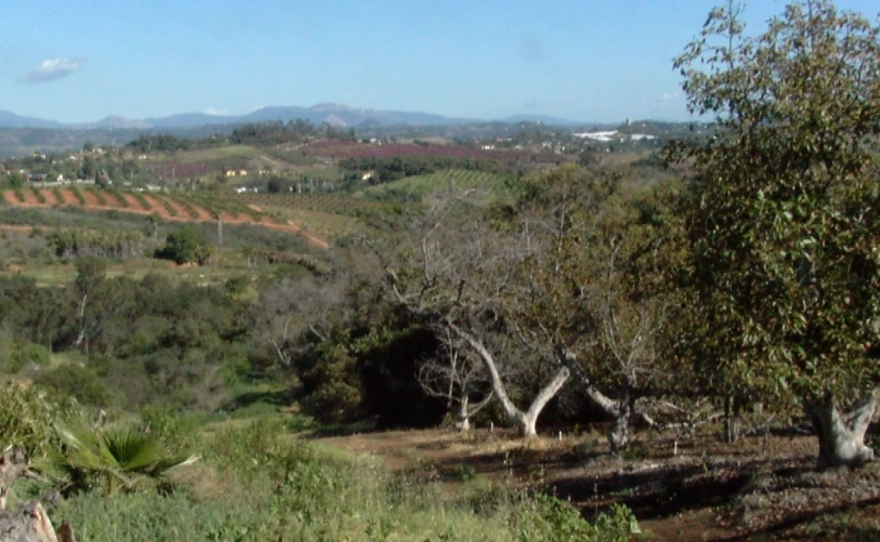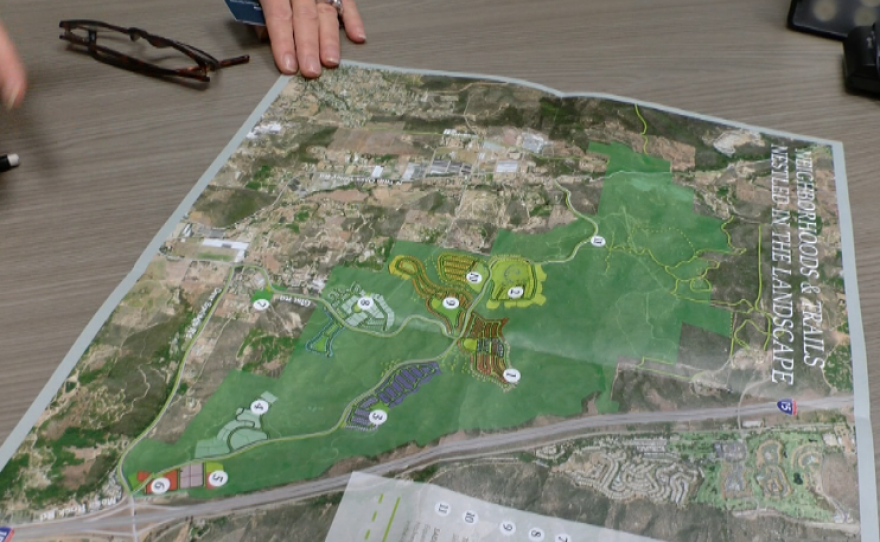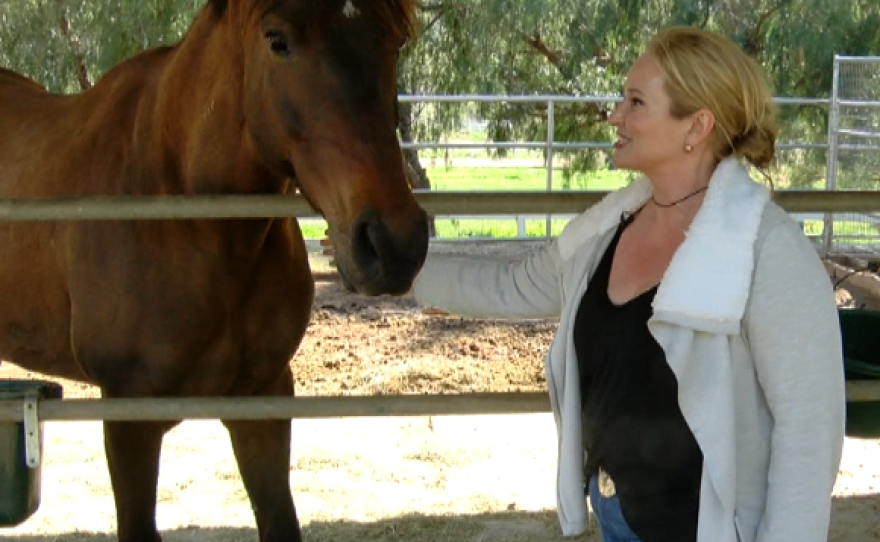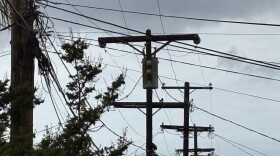The recent defeat of Measure A, which would have led to the development of lagoon-front property in Carlsbad, has not discouraged the developer of the proposed Lilac Hills Ranch in Valley Center from trying the citizens initiative approach.
Signature gatherers outside grocery stores are likely to have Lilac Hills Ranch on their clipboards. But the developer of another master planned community on Interstate 15 — Newland Sierra — is taking a different approach.
Lilac Hills
Elizabeth Buenrostro recently moved with her family to rural Bonsall. She’s happy here. She has room for her kids, her dogs and a stable of horses. But she misses the community she had when she lived in more urban San Marcos.
Buenrostro is one of half a dozen proponents of a citizens initiative to approve a new master planned community in nearby Valley Center called Lilac Hills Ranch. It would build 1,700 homes and a town center on what is now lemon groves and rolling hills.
“I really feel that the Lilac Hills Ranch is a solution to a big problem that we have,” Buenrostro said, while sitting on the lawn outside her home. “We have a big housing crisis, and I don’t know where my kids are going to live. I love this project. “
Plans for Lilac Hills have been in the works for several years. In 2011 the developer, Accretive Investments, applied for an amendment to the recently passed county General Plan, which calls for 110 homes to be built on the site. But Accretive is not confident the project will pass the county Board of Supervisors.
One of the key votes is Supervisor Bill Horn, who has been advised by the state’s Fair Political Practices Commission that it would be a conflict of interest to vote on Lilac Hills. Horn's Valley Center house is a couple of miles from the site.

Instead of relying on the Board of Supervisors, Accretive has decided to launch an initiative, with the help of half a dozen citizens, including Buenrostro.
“What the initiative is, is to get the project on the ballot, so that the citizens of San Diego can vote for it or vote against it," Buenrostro said.
Though Carlsbad voters last month defeated Measure A, which would have allowed a shopping center on a lagoon, the initiative to build a housing development in rural Valley Center could be a different story.
Gary London, president of the London Group, is a realty adviser who specializes in the marketing and feasibility of development projects.
“This is a housing project, so this brings to the public consciousness this issue of housing," London said. "And ultimately, when it gets voted upon, it will get voted in the entire region. We’ll have a much larger regional conversation over whether or not and how we provide for housing in our region.”
Housing is increasingly unaffordable in San Diego because not enough new homes are being built, London said. And much of the available land in San Diego’s urban areas is gone.
“Most of the developable land is in the unincorporated areas, which is the jurisdiction of the county Board of Supervisors,” London said. “We can’t just hide our heads in the sand and say, ‘If we don’t develop it, they won't come.’ People will come. The community is going to grow regardless."
London said he hopes the issue of where to build does not pit city residents against backcountry residents, because the region is going to need new housing in urban and rural areas.
Like many developers, London believes the traditional review under the California Environmental Quality Act is too slow and expensive. Attempts to reform CEQA have gone nowhere, and that's why developers started looking at citizens initiatives, he said.
“It’s a strategy on the part of the developer, and it’s being watched very carefully in the development community and certainly by public policy makers,” London said. “The initiative process is sort of a messy way to get around the elephant in the room issue, which is that our CEQA rules are in immediate need of refinement and adjustment.”
Newland Sierra
But not all developers are giving up on CEQA.
“We’re going to continue forward in the traditional plan amendment process,” said Rita Brandin, development director for Newland Communities.
Newland is working on another big master planned community on rural land west of Interstate 15, about 10 miles south of the Lilac Hills site.
Brandin said Newland’s strategy didn’t change when the California Supreme Court ruled in 2014 that a citizens initiative trumps other state environmental reviews and could be used for project approval.
“It wasn't an 'Aha' moment for us as developers to say, ‘Oh, this would be an easier route,'" Brandin said. “We don’t see that it is an easier route.“
In Carlsbad, developer Rick Caruso spent more than $10 million on Measure A and it still failed.
One reason Newland has not chosen the less rigorous process of an initiative, Brandin said, is because Newland is picking up the pieces of a previous North County planned development called Merriam Mountain, which failed to gain approval from the Board of Supervisors in 2009.
“There was a significant amount of negative (feelings) from the prior project, and we wanted to have as much transparency as possible,” she said.

Newland has downsized the number of previously proposed houses from 2,600 to about 2,100. The layout of the community is also different: It would cover about 380 acres of the nearly 2,000-acre site.
“We wanted to create the more compact neighborhoods versus spread the development over the entire site,” Brandin said.
In spite of the challenges this project site has faced in the past, she does not believe CEQA is the problem.
“CEQA is an amazing guidepost for projects of all sizes to determine their environmental impact,” she said. “What’s broken is not CEQA necessarily. It’s the misuse of CEQA, because it’s not a secret that CEQA lawsuits always come after a project is approved."
Brandin says Newland has factored the cost of CEQA lawsuits into its plans to get the project approved.
“We’ll probably spend $10 million all told when done,” she said.
The Newland Sierra project may come up before the Board of Supervisors for a vote next year. Like Lilac Hills, it needs an amendment to the county’s General Plan for growth.
Amending the county plan
Back in rural Valley Center, former county Planning Commissioner Patsy Fritz worries that more than a decade of public meetings on the General Plan could be wiped out by a November initiative, and with it, their rural lifestyle.
“Ballot box zoning has never been successful,” she said. “The General Plan should last 20 to 30 years — it was designed to do that. That’s why it took 13 years, it cost you and me and (the public). Everyone in the county had to pitch in to pay $18 million to get a balanced General Plan.”
Fritz is skeptical that approving Lilac Hills and building 1,700 homes where 110 homes are called for in the General Plan will make housing any more affordable.
“Housing crisis is a wonderful catchy phrase," she said. “None of this is going to be affordable by someone who has, say, a household income of less than $100,000 a year."
Fritz acknowledges there is a need for more homes in San Diego County, but she said they should be built where the General Plan calls for it — where wide roads are already being developed leading to Valley Center’s existing town center, not on land zoned for agriculture.
“That is because the developer believes he can get cheaper land out here," she said. ”There are fewer people to contend with."
Fritz knows that voters in the rest of the county, already facing numerous ballot initiatives, are unlikely to make the kind of informed decisions that years of community planning have reached.
“We can’t expect every voter to read every word of all the initiatives that are going to be on the November ballot, and there are a ton of them. So it’s like saying, 'Well, it’s not in my backyard,’” she said.
Signature gatherers are on the streets now, collecting signatures for a November ballot initiative on Lilac Hills.
Though more than 3 million people live in San Diego County, only 67,000 signatures are needed to qualify an initiative. The Registrar of Voters Office said that’s the required 10 percent of the eligible voters who turned out in the last gubernatorial election in 2014.
The proponents of Lilac Hills have until August to collect those signatures, which they can then take to the Board of Supervisors. The supervisors will then face the same choice the Carlsbad City Council had with Measure A: approve the project or put it on the ballot for a vote.






